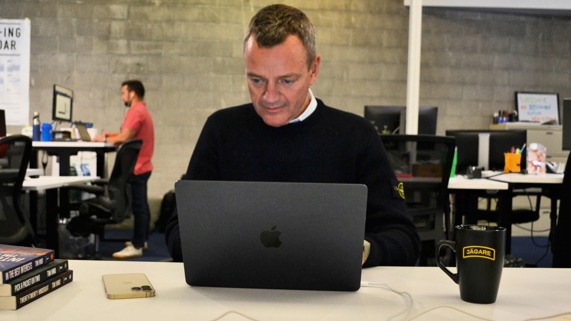Cooling pipes, server racks and emergency plans: Touring the heart of Mastercard’s network
May 7, 2025 | By Ben Fox Rubin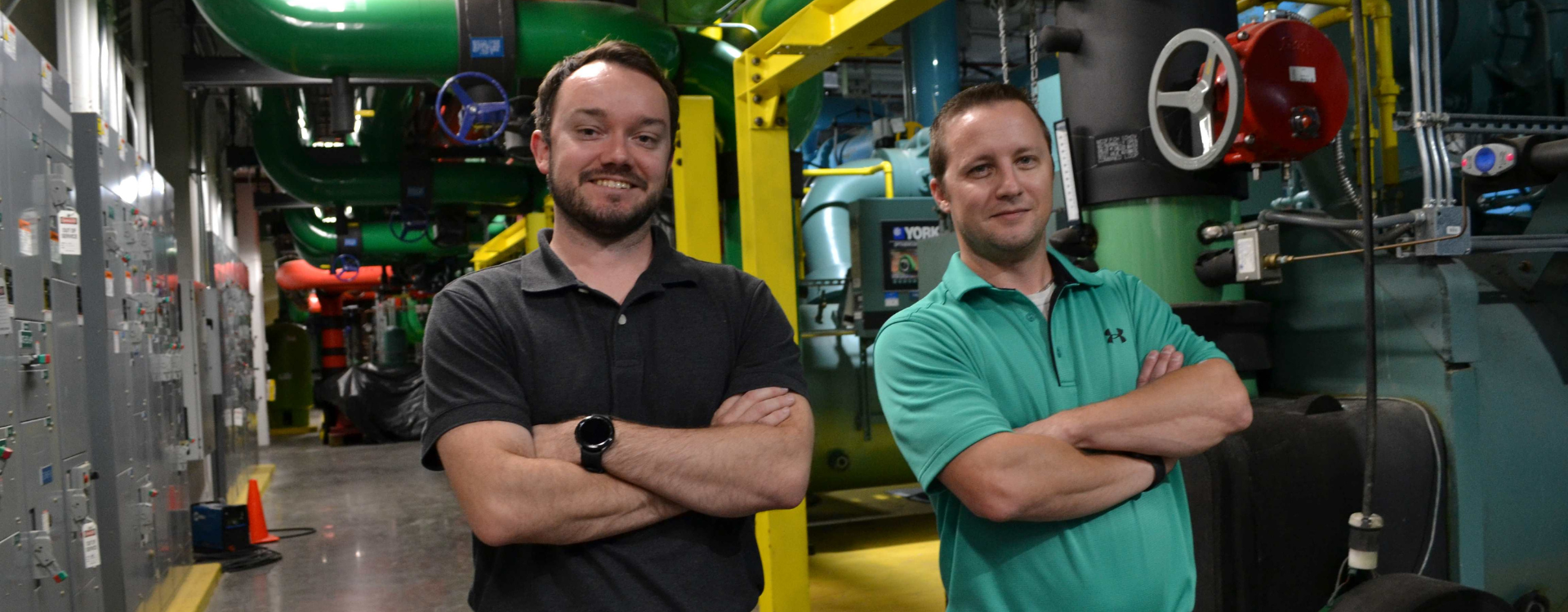
The office is undoubtedly nice — meeting pods accented with wood slates, a barista near an entrance and lakeside views from two-story-tall windows. But then a group of us go to the basement and pass a heavy metal door with the words “Energy Center” painted in white on it and the place is suddenly very industrial-looking and very noisy.
When you tap your card to buy something, you very likely aren’t thinking much about it. But behind the scenes, there’s an incredible amount of effort going on to make sure that payment works the way it’s supposed to every time, with your transaction zipping along an invisible digital highway where it gets routed, processed and authorized in milliseconds.
I stopped by Mastercard’s St. Louis Tech Hub to see what that behind-the-scenes work looks like. The company has been in St. Louis for decades, at first — when communications networks were slower — because being in the middle of the country was useful to manage transactions from coast to coast. The current office, which first opened in 2001 on the site of a former turkey farm, is built around the company’s largest data center worldwide, making it a central hub for Mastercard’s network processing, security operations and research and development.
Here, technologists keep a vigilant eye on Mastercard’s global network 24/7 in a NASA-like mission control space on one floor and engineers diligently maintain the Energy Center in that noisy basement to make sure the data center, which manages hundreds of millions of payments a day, has the electricity and cooling it needs, even in extreme weather.
It’s already a big undertaking to maintain this global network, which includes dozens of data centers, as well as public cloud connections, undersea cables running across continents and thousands of network servers stationed at banks, fintechs and merchants all over the world. But added to that, Mastercard is also working on a massive, yearslong transformation of that very same network.
“We have a dual charter,” Ed McLaughlin, Mastercard’s chief technology officer, says. “Run the business while we build the future.”
A leading motivation for this huge upgrade is speed. The world is moving faster than ever, people expect things to be immediate, whether that’s online deliveries, video-game downloads or ChatGPT responses. They want it now. But a lot of money travels much slower than that. That’s starting to change, as many financial services players are building more real-time capabilities into their operations.
For Mastercard, that involves developing its next generation of network hardware and software that’s faster, more streamlined, more resilient and more flexible. With faster money movements, economies can operate more efficiently and grow, and small businesses can get paid more quickly, and then use that money to restock supplies.
For consumers, all these upgrades should ensure their money works for them exactly how, when and where they want. You want to send money via this app? Sure thing. You want it to arrive ASAP? No problem. And if all these behind-the-scenes upgrades happen as planned, you won’t even notice — your money management will become easier and faster and you’ll just keep moving along with your day, just like when you tap your card.
And St. Louis is a key piece of this massive effort. “It’s one of the main engines that drive our business, what we do on a global scale,” says Nicole Turner, who leads the company’s workplace experience team. “A lot of our tech and innovations that start there go out across Mastercard.”
Welcome to the rainbow room
My tour guide through the Energy Center is an affable guy named Daniel Canavan. Crew cut, green Under Armour polo, jeans with a set of keys dangling from the side. He's spent 17 years working on mechanical, electrical and HVAC systems — 12 of those at Mastercard. He seems to have an encyclopedic knowledge of the basement floor, as he rattles off all kinds of stats and figures while walking our small tour group of Mastercard employees around.
“This is the heart of the data center,” he says, while pointing out that the data center is in fact right above us. “I call it the heart because it’s mechanical pumping, it’s the electrical source. Everything is here that feeds all your arms and fingers upstairs.”
As the next evolution of the Energy Center’s operations, Mastercard bought 40 acres adjacent to the St. Louis office, using part of the land to build a solar farm. That new farm, along with an existing set of solar panels built atop the parking lot, will allow the company to run its power-hungry data center with renewable energy and help it reach its goal of net-zero emissions by 2040. It's one of several sustainability investments Mastercard is making in the St. Louis area, including a renewable energy partnership with a local utility provider.
The recurring theme of Canavan’s tour is that there’s a Plan B and a Plan C and a Plan D for just about everything down here to make sure the data center can keep processing transactions. For example, the building has several electrical feeds from separate substations providing power to multiple electrical rooms, so if one fails, no big deal. If they all fail, there's an army of huge generators with plenty of fuel onsite.
It’s the same story with water. There are multiple chillers sitting in a loud room surrounded by snaking blue, green and orange pipes — Mastercard's real-world rendition of Super Mario. Those chillers require a constant flow of water so they can cool the data center, so there are multiple contingencies built in, including 50,000-gallon water tower basins, a water connection for mobile delivery and — if all else fails — the team practices once a year using a specialized pump to draw water from the nearby 10-acre man-made lake.
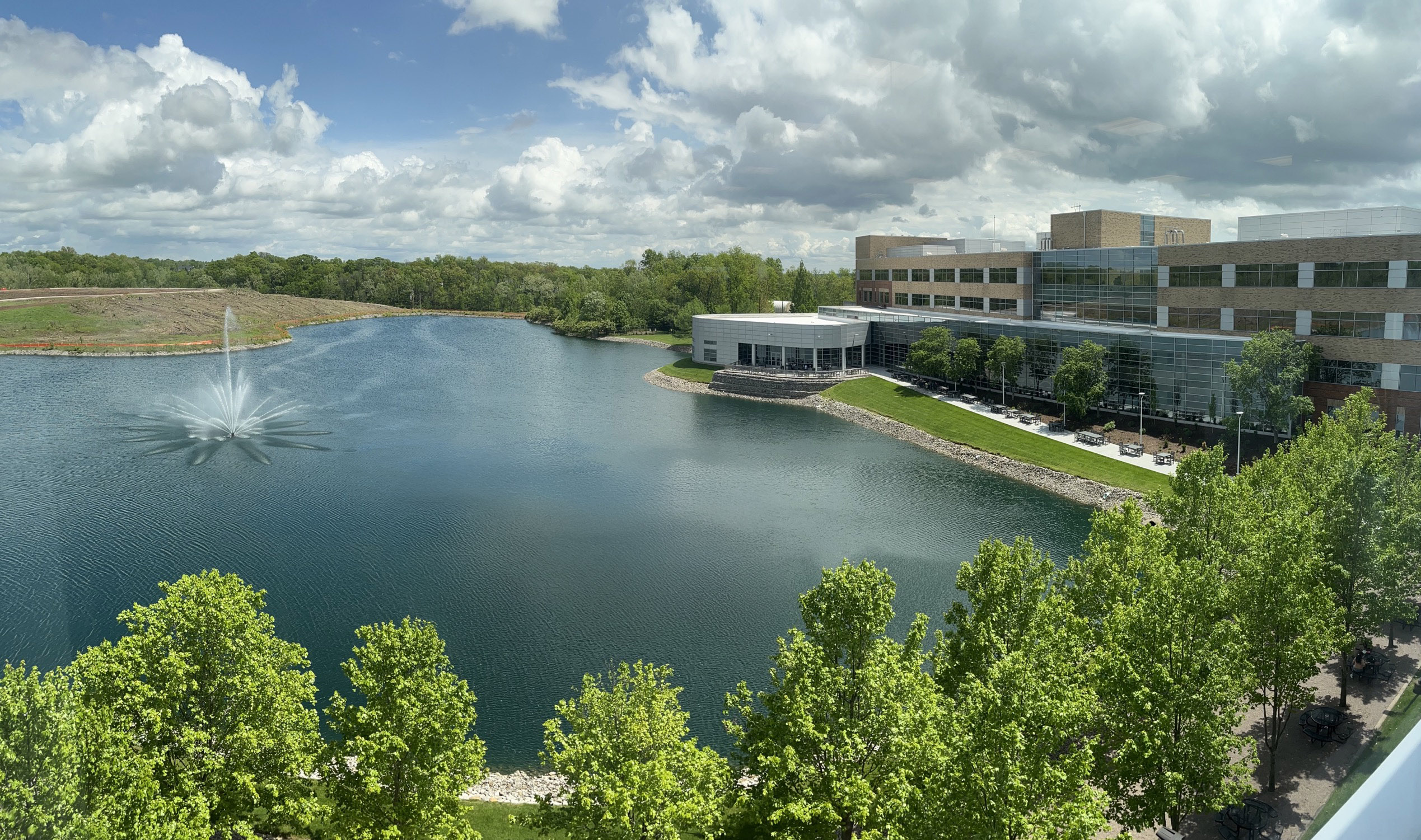
The lake outside Mastercard's St. Louis Tech Hub is more than scenic — it serves as a back-up source of water for the company's chillers, which cool the company's data center. (Photo credit: Mira Belgrave)
I will admit, I had no idea that one of the leading payments companies in the world had that many backup systems, including — literally — a lake.
One of our last stops was a room filled with large black boxes called uninterruptible power supplies, or UPSs.
Above the UPS boxes are meticulously laid out wires in different colors that wind around the room like we're in Willy Wonka’s factory. These wires go up to the ceiling to feed power into the data center above us, ensuring a continuous flow of power to the servers. “They call this the rainbow room,” Canavan says.
Oh, and this extremely complex room filled with equipment has an identical twin right next to it because, as I mentioned, there’s always a backup.
In the library
The next day, I stop by Mission Control & Operations, aka the MC&O. It’s stationed right by the data center, which is a highly secure, tightly monitored room filled with rows and rows of black servers. Teams in the MC&O monitor the Mastercard network all day, all year. Inside, behind a series of locked doors and down a corridor, is the workspace, with high ceilings, clusters of desks and a series of large monitors at the front of the room. Along the walls are red digital clocks showing different time zones: St. Louis, Shanghai, Lagos, Sao Paulo, Belgium. It’s library quiet while I’m there.
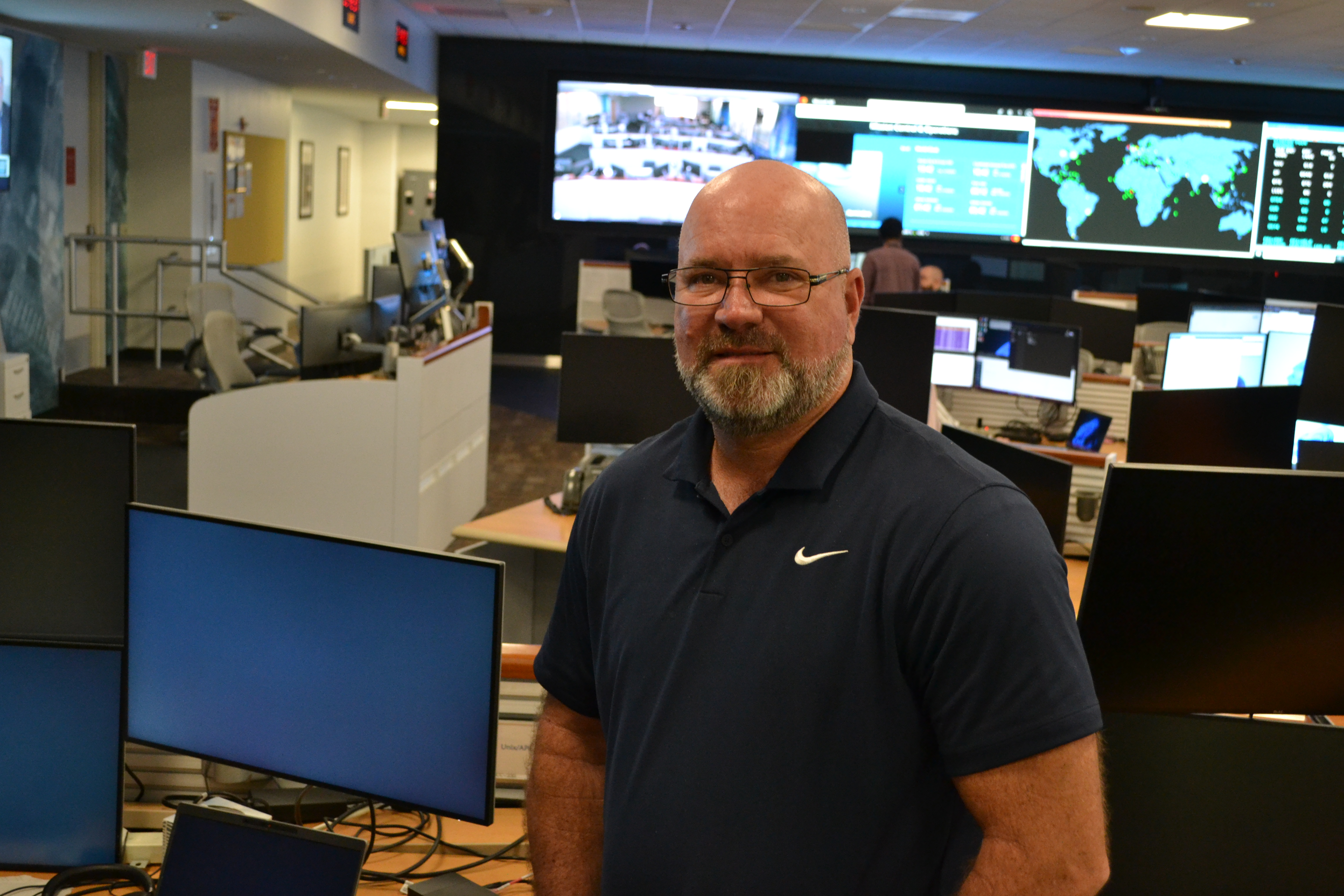
Ken Whitfield manages St. Louis's Mission Control & Operations, one of six worldwide that monitor the Mastercard network all day, all year. (Photo credit: Ben Fox Rubin)
Ken Whitfield, who helps manage the space, tells my group about the team’s work here. He has a salt-and-pepper beard and a deep, patient voice that suggests he’s wrestled down all kinds of network complications and lived to tell the tale. This is one of six MC&O locations worldwide and the numbers the teams work with are staggering. Last year, there were nearly 160 billion transactions that ran through the Mastercard network – that’s about 436 million per day.
To make sure those billions of transactions run smoothly — in every hour of the day, in the nearly every country in the world, in dozens of currencies and even across borders — Whitfield and hundreds of others monitor about half a million alerts every month. The teams need to sift through those alerts, prioritize what matters, and — in the most serious cases — pull together technical response teams to troubleshoot and fix a problem as quickly as possible. Mastercard’s monitoring work also regularly catches problems in banking customers’ systems and will proactively tell them about it, Whitfield says.
Just like with the Energy Center, there are a ton of contingencies built in. To ensure the Mastercard network can stay up, monitoring teams are in different places around the world and the network itself includes a variety of resiliencies, from undersea cables to cloud connections to thousands of mini network servers at Mastercard customers’ sites that can autonomously manage transactions in case of an outage.
At one point, Whitfield directs our attention to the front of the room, where a large monitor is showing a big world map with circles that flicker green and white, each showing a Mastercard network connection with a customer. The bigger the circle, the more transactions are running through that connection. "It’s not all the customer sites,” Whitfield says of the map, “because if we did that, the whole map would be green.”
Walking out of the MC&O, our tour of Mastercard’s factory floor ended up in a variety of cybersecurity operations. There’s the Fusion Center, a collaboration space where teams across the company proactively prepare plans before a potential crisis even happens. Affton Hennerich, who helps run the Fusion Center, tells us how the teams there research the implications of future 6G telco networks and artificial intelligence. “It enables us to move faster by having those scenarios plotted out,” she tells us.
In the neighboring room, there’s the Security Operations Center, which keeps an eye on Mastercard’s physical and cyber infrastructure, and down the hall is the Digital Forensics Lab, one of only a handful of privately accredited crime labs, used to investigate cybercrime.
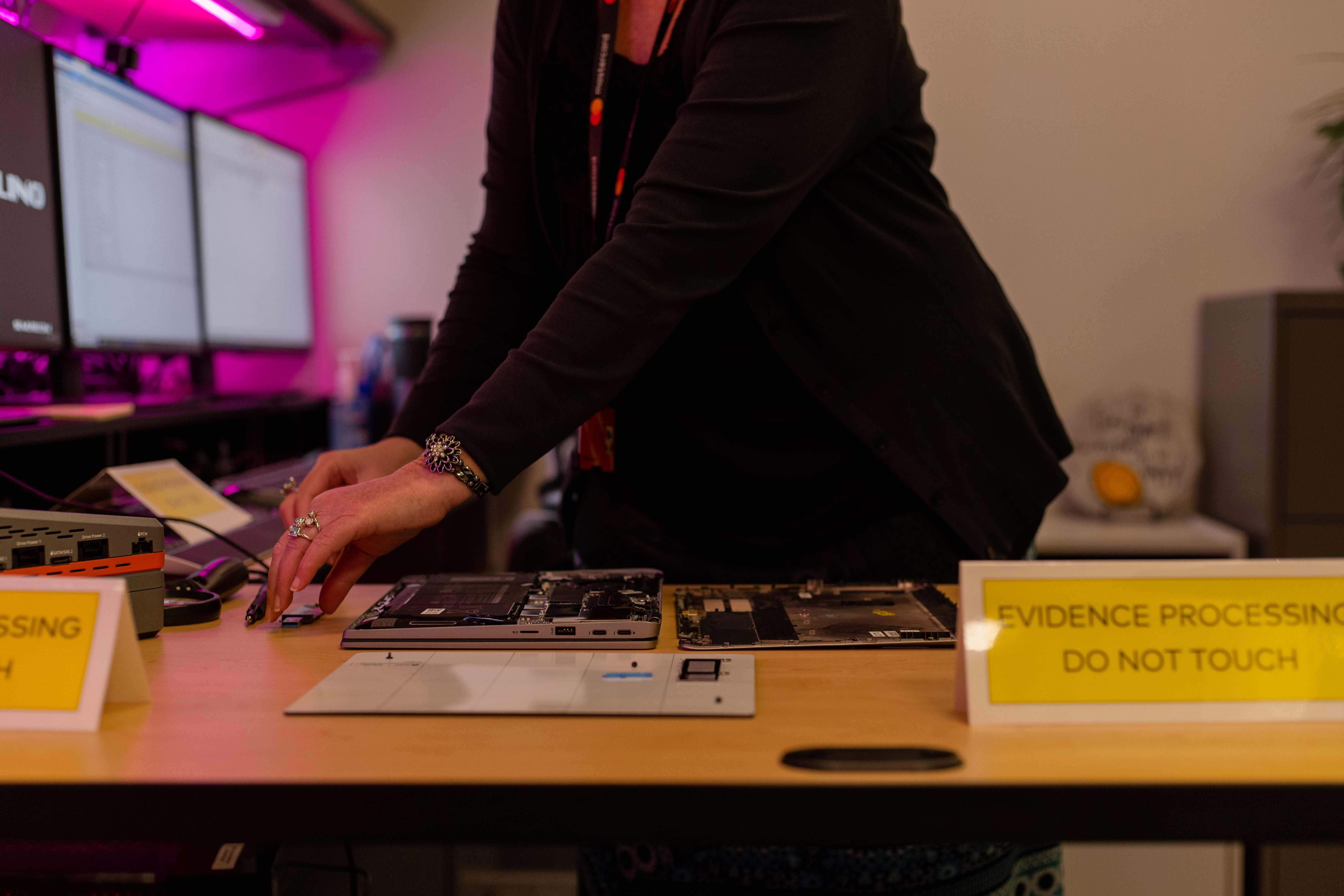
The St. Louis Tech Hub is also home to the Corporate Security Investigations team, which conducts digital forensic investigations into global threats and risks across Mastercard.
“From St. Louis and locations around the world, we power economies – connecting billions of people to what they need and want, quickly, seamlessly and securely,” McLaughlin, the company CTO, adds. “The Mastercard brand is a promise. Our technology and operations are how we strive to keep it, every day, every time.”
I leave that day thinking about how much Mastercard’s network operates as a living, breathing system, similar to other huge but often invisible operations like wireless networks and electric utilities that people like me simply take for granted – just tap your card and keep going along with your day. But as I saw behind the scenes, there are thousands of people like Canavan and Whitfield and Hennerich who are working every day to keep the network running and finding new ways to make it even better.
Banner photo: Eric Gifford, left, and Daniel Canavan, with Mastercard's Real Estate Services team, in the St. Louis Tech Hub Energy Center, which powers and protects the company's servers. (Photo credit: Ben Fox Rubin)
